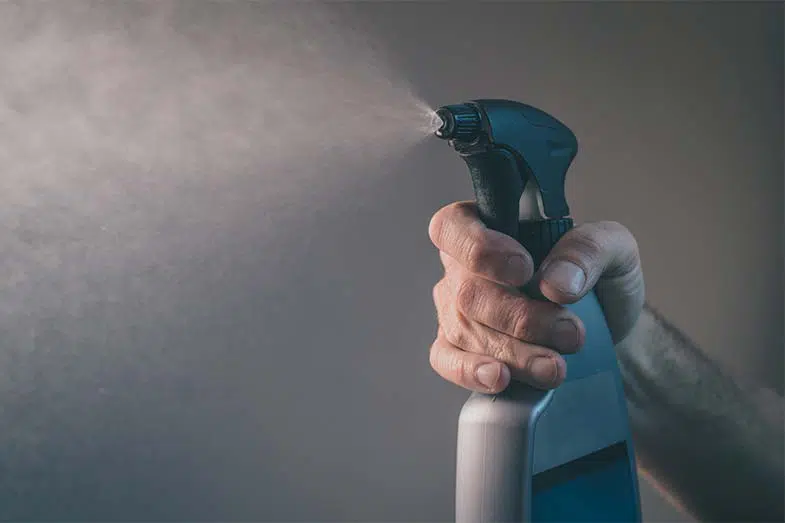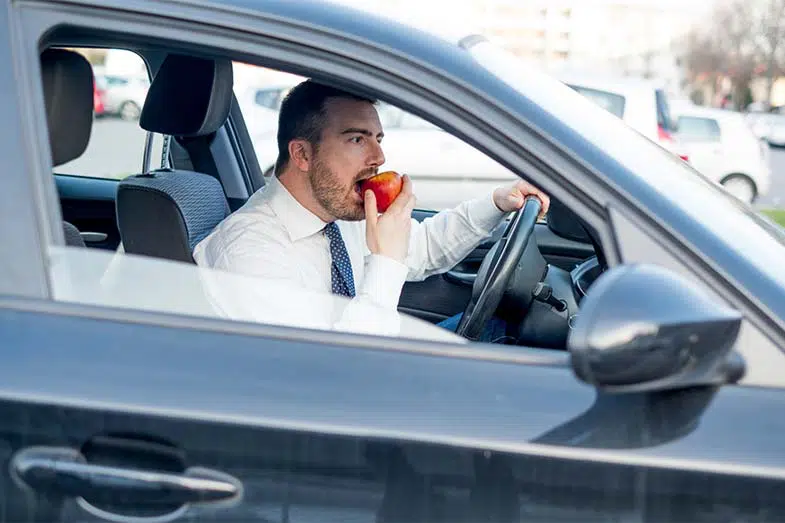People in California, Utah, and other comparable regions have grown used to the presence of bees in their daily lives. They often encounter these nectar-sucking creatures in their gardens or backyards.
But one place they will never get used to is finding bees inside their vehicles. If you find yourself in a similar situation, this article is a must-read!
Getting a bee out of your car can be an arduous task and entails using commercial products, bee-repellent devices, and DIY remedies. While some techniques are more effective than others, the best way to keep bees away from your vehicle is by employing preventive measures.
However, not all circumstances permit getting rid of bees through prevention.
Here are 9 tips on how to get a bee out of your car:
- Pull over to safety.
- Open up all your car doors.
- Concoct your own sugar water.
- Drop the sweets.
- Ward bees off with natural plants and essential oils.
- Use a DIY bee spray.
- Use a subsonic or an ultrasonic bee repellent.
- Fumigate your vehicle.
- Call in a beekeeper or professional.
Don’t panic. Intrinsically, bees are not aggressive — they will only attempt to attack you when provoked. Staying calm and focused in situations like this may be easier said than done. But you must do to avoid getting stung or meeting any untoward road accident.
How to Get a Bee out of Your Car

1. Pull Over to Safety.
Turn on your hazard lights, and gradually slow your vehicle down. Next, pull over to a shoulder (if one is available). If there is none, pull off to the nearest pump station, exit, or parking space.
Driving to a safe zone away from moving traffic may be a stretch for people with anaphylaxis (severe allergic reaction to bee stings). However, it is necessary if you want to get rid of the bee in your car without the risk of an on-road accident.
2. Open up All Your Car Doors.
You’re lucky if you notice a bee in your car while parked. Slowly get out of the car, open all doors (not windows, keep them rolled up), and let the bee scram on its own.
If the car is in your garage, push the car and take it a good ten paces away from your house. You can ensure the bee does not fly toward your home once you let it out of the vehicle. If you are in a public parking area, open all doors and distance yourself from your car while waiting for the bee to come out.
Trying to get rid of bees in the car while driving is a different story altogether. Not only does it cause a whole new level of fear and anxiety (especially if you are allergic to bees), but it also is the perfect setting for an accident waiting to happen. Under no circumstances should you make frantic movements or attempt to get rid of the bee while driving.
The best you can do is slowly roll your car windows down to encourage the little winged guest to fly out. If the bee does not leave, the next best thing to do is pull off the road.
3. Concoct Your Own Sugar Water.
Bees are naturally attracted to sweet flavors resembling the nectar they draw from flowers. Hence, the presence of something sweet will likely help draw them out of your car. Mix 1 teaspoon of sugar and 3 teaspoons of water to replicate a nectar-like flavor. You can mix them either with a blender or by hand.
Prepare this concoction beforehand and put the mixture in a small cup to attract bees when needed. A medium-sized mason jar filled with sugar water and stored in your glove box should be enough.
4. Drop the Sweets.
As established earlier, bees are generally attracted to sugary and sweet fragrances. So, if you eat candies, fruits, granola bars, juices, or soda while driving, you may find a bee in your vehicle soon.
The likelihood of this visitor buzzing around your passenger seat increases during summertime, when bee colonies are generally most active. To keep these yellow-jacket fellows at bay, it is best to avoid eating sweet things inside your car — regardless of the season.
5. Ward Bees off With Natural Plants and Essential Oils.
A good way to keep bees out of your vehicle is with essential oils. Unlike the fragrances that come from sweet food and drinks, bees despise the scent of some essential oils and plants that we find fresh and calming.
Examples of these scents are cedarwood, citronella, clove oil, eucalyptus, geranium, and peppermint. Vinegar spray and garlic aromas are the best for fending off bees, but these last two are not exactly scents you would find therapeutic or like to stick to your car interior and upholstery (view on Amazon).
Other scents not talked about often but just as effective include almond. According to Sam Westreich, Ph. D., bees will generally avoid anything with the said smell. Beekeepers even use a specific kind of almond oil to “encourage bees to leave the hive” come time for harvesting honey.
It would be a good idea to wipe down your car’s seals, doors, and hatches with an ample amount of almond oil to keep your yellow-jacket visitors out. Conversely, veer away from citrusy, banana-scented, or lavender-scented oils, as these aromas tend to lure bees (if not make them go wild).
6. Use a DIY Bee Spray.

This preventive measure uses the same bee-repelling substances in essential oils mentioned earlier but in the form of a spray. Once concocted, the spray is good to use on clothing and bee-prone areas in and around your vehicle like upholstery, mirrors, windows, and seals (to name a few).
However, the spray is not to be used against the bee while you are inside the vehicle. Doing so may agitate your uninvited guest, causing it to sting you instead of leaving your car premises.
7. Use a Subsonic or an Ultrasonic Bee Repellent.
Bees are vital to our ecosystems. Modern-day methods of warding them off have shifted from using poisonous substances and traps to ultrasonic devices (view on Amazon). These devices emit short-wavelength, high- or low-frequency electromagnetic sound waves that deter bees. Most are plugged into a standard electrical outlet, while others run on a battery for more convenient usage.
Because this is a relatively new technology and not commercially available in all regions, its effectiveness in deterring bees compared to other recommendations in this guide has yet to be proven. Long-term usage of these repellers may cause neurological side effects on house pets susceptible to these types of sonic waves. Exercise caution when using these devices.
Opt for a battery-operated ultra-/subsonic device. You can turn it on and let it do its magic inside your car without you being there. It is your discretion to go for a different variant. However, I have yet to find one sold commercially that can be plugged into a vehicle’s accessory outlet.
8. Fumigate Your Vehicle.
This method is not something you can readily perform upon discovering bees in your car while driving. But it is one of the most effective ways to get rid of your winged guests without harming them. Nowadays, fumigation is understood as entailing the use of chemicals. Initially, however, it was a perfumery process that literally meant “through smoke” (Latin: per fumus) and only used resins or plants.
You can opt for incense perfume fumigation to get bees out of your car. You may use a traditional incense burner or an electric one, put your preferred incense on it, and perfume the inside of your vehicle with the smoke (while leaving all doors open). If you do not have an actual burner, use a hairdryer with an incense stick stoked in — it will have the same effect.
Fumigation sort of mimics a forest fire for bees (due to their hypersensitive sense of smell) and would consequently cause them to flee the moment they smell the scent from your vehicle. You may need to get rid of the smoky smell, similar to how you would get rid of a cigarette smell in your car afterward. But that would be a more welcome problem than being bothered by a bee.
9. Call in a Beekeeper or Professional.
Especially if your vehicle has sat too long in the shed or garage, you may find yourself dealing with several bees and not just one. Things can even get to where they have started treating your vehicle as a temporary home.
In cases like this, getting them out of your car may no longer be that manageable. It would then be high time to call in for professional help when this happens.
Why Bees Are Attracted to Your Car

Apart from correctly dealing with bees that find their way inside your cabin, it is also crucial to understand what causes them to invade your vehicle in the first place. Knowing these triggers would tremendously help choose the best course of action.
There are a few reasons bees are attracted to vehicles (not just those painted in white).
- It is a probable food source or near one. If you eat in the car, the smell of food is likely to remain inside the cabin. This naturally attracts bees (not to mention other types of pests and rodents).
- You frequently park your car near a sweet-smelling, fruit-bearing tree.
- You also unwittingly kill many small insects (another food source) when you drive, and their “juice” sticks to your tires and eventually attracts bees.
Another reason is that your vehicle is a probable nesting place, with the engine staying warm after use and being protected by the hood. Regularly parking your car inside the garage for the night is not guaranteed that bees will not target it as a temporary home. They can easily get into the shed through holes and other small crevices.
Conclusion – How to Get Bees in a Car Out
In summary, here are the nine ways how to get a bee out of your car:
- Pull over to safety.
- Open up all your car doors.
- Concoct your own sugar water.
- Drop the sweets.
- Ward bees off with natural plants and essential oils.
- Use a DIY bee spray.
- Use a subsonic or an ultrasonic bee repellent.
- Fumigate your vehicle.
- Call in a beekeeper or professional.
Prevention is the best way to get these winged critters out of your vehicle. And it all starts with keeping your wheeler clean and well-maintained. Owners with well-kept cars are less likely to invite bees inside their cabins, making their daily commute and general driving experience smooth, enjoyable, and worry-free.
Kris is an avid off-roader and outdoor enthusiast who loves to brave the elements and take on challenging terrain. He also enjoys sharing his passion and knowledge with others so that they, too, can appreciate the ride.
About Kris
